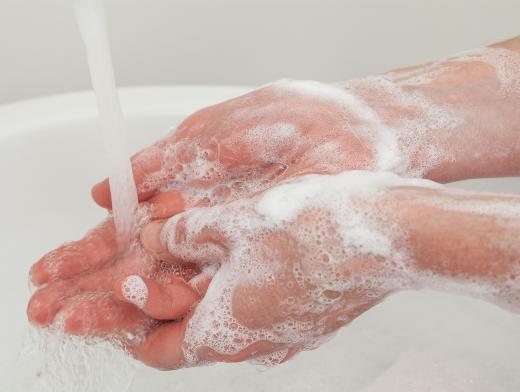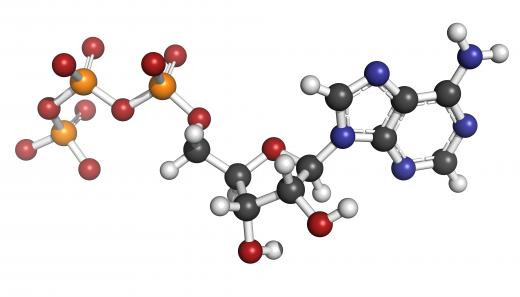What Is Hydrolysis?
Hydrolysis is a type of chemical reaction that occurs between water and another compound. During the reaction, chemical bonds are broken in both molecules, causing them to break apart. The water molecule splits to form positively charged hydrogen (H+) and negatively charged hydroxide (OH-) ions, and the other molecule splits into two simpler sections, also with positive and negative charges. H+ and OH- ions attach to each of these sections. These reactions take place when some ionic compounds, for example, certain acids, bases, and salts, dissolve in water; they are involved in processes that are essential to life; they are used in some important industrial processes, such as the manufacture of soap; and they play an important part in the weathering of rocks.
Ionic Compounds

Ionic compounds can be acids, bases or salts, which are compounds that result from the reaction of an acid and a base. They are made up of positively charged cations and negatively charged anions. When they are dissolved in water, they will split into their cations and anions. The anions of weak acids, and the cations of weak bases, will react with water to some extent, resulting in hydrolysis.

Where a salt is the product of a strong acid and a weak base, the cation of the base will hydrolyze in water. For example, ammonium chloride (NH4Cl) is the salt of a weak base — ammonia (NH3) — and a strong acid — hydrochloric (HCl). When dissolved in water, it splits into cations and anions — NH4+ and Cl-, respectively. The cation, however, will react with water to some extent by losing a hydrogen ion:

Since this reaction produces hydronium ions (H3O+), the resulting solution is acidic. Where a salt is the product of a strong base and a weak acid, the anions of the acid will react with water by accepting hydrogen (H+) ions, leaving hydroxide (OH-) ions, which gives an alkaline solution. The salt of a strong acid and a strong base will not hydrolyze because the anion of the acid and the cation of the base do not react with water.
Life
Many processes that are essential to life involve hydrolysis. An example is the release of energy by the molecule adenosine triphosphate (ATP). Cells use this compound to store energy, which can then be released when it is needed. The molecule has three phosphate (PO4-) groups, but it can lose one of these groups by reacting with water. This reaction actually uses up a small amount of energy, but much more is released by the subsequent reactions of the free phosphate group.
Hydrolysis is also plays a vital role in the breakdown of food into easily absorbed nutrients. Most of the organic compounds in food do not react readily with water, and usually a catalyst is required to allow these processes to take place. Organic catalysts that help with reactions in living organisms are known as enzymes. In the body, enzymes such as lipases, carbohydrases and proteases catalyze the reactions with fats, carbohydrates and proteins with water.
One example of hydrolysis is the breakdown of starch, which is catalyzed by the enzyme amylase. Starch is broken down into smaller molecules, which consist of the sugar known as maltose. Maltose may then be further broken down into glucose molecules, under the influence of the enzyme maltase. In each case, water takes part in the process, itself splitting and adding a hydroxyl group and a hydrogen ion to the new molecules formed on each side of the broken bond.
Industry
Many industrial procedures require various substances to be hydrolyzed to create useful products. Often, however, the raw materials for these processes do not react easily with water molecules, so the reactions are helped by a variety of means, such as high pressure, high temperatures and catalysts. Laboratory hydrolysis usually requires the use of a catalyst, which is typically a strong acid or alkali.
Hydrolysis has been used for a long time in the production of soap. During this process, known as saponification, fat is hydrolyzed in a reaction with water and the strong alkali, sodium hydroxide. The reaction produces fatty acid salts, commonly known as soap. Saponification sometimes occurs in old oil paintings when fatty acids in oil paint react with the metals in paint pigments. This can cause white deposits and lumps to develop on the surface of paintings, although it is not known why it only occurs on some artworks and not others.
Weathering
Hydrolysis is an important process in the weathering of rocks. Various silicate minerals, such as feldspar, undergo slow hydrolysis reactions with water, forming clay and silt, along with soluble compounds. This process is important in the formation of soils, and in making essential minerals available to plants.
AS FEATURED ON:
AS FEATURED ON:













Discussion Comments
Is there a usage of hydrolysis in power generation industry?
@DentalFloss- I went to a college that had Norwegian ancestry, and they served lutefisk every year. I had forgotten that it used hydrolysis, though. Funny; I wonder if you could use a piece of lutefisk as soap!
I personally cannot think of hydrolysis and soap without also thinking of fish- specifically, lutefisk. It is a Norwegian dish, mainly eaten these days by Norwegian Americans. This dish is made by soaking dried, salted fish in lye for an extended amount of time. This makes the fish turn into a sort of gelatinous form, and when cooked it is either boiled or pan fried, usually, and then served. The taste is, well, what you might expect fish covered in lye to taste like.
Does anyone here have any idea of the industrial processes that use hydrolysis to make their products? I have been trying to think of some, but can't really come up with anything.
Since the article talks about hydrolysis being used to split up starches into glucose, the thing I was kind of thinking about might be in sugar production somehow.
If you had sugar cane or beets or something and needed to separate the sugar from the rest of the plant, you might be able to use hydrolysis to get what you needed.
I was reading something about ethanol the other day, too. Part of the problem with that is that it is hard to separate all of the parts of a plant into things you can and can't use, so I think hydrolysis might have a purpose there, too.
Does anyone else have any ideas?
@Izzy78 - I agree. The ways our body gets us nutrients is really spectacular. Besides the things mentioned in the article like breaking down starches, what I was thinking about was how our white blood cells kill bacteria. I don't know it for a fact, but I would be willing to guess that they use some sort of hydrolysis reaction.
I know they have different molecules that they use to break apart, or lyse, bacteria. I assume that they work because the molecules react with the water molecules in the bacteria and cause them to break apart. The interesting thing would be how the white blood cells stop the molecules from tearing them apart.
The other part of the article I like was the weathering of rocks. I knew it was causes by wind and water, but I guess I had never really thought about the actual chemical processes that worked to break down a rock.
@jmc88 - Good question. I actually just got done watching a TV show that demonstrated how they make soap. They talked about hydrolysis, which led me here.
Basically, lye is the sodium hydroxide that was mentioned in the article. Whenever fat and lye mix, they cause the byproducts to form, and that is what we use to wash our hands. The way it works is because the fat molecules can combine with dirt molecules and then the water washes them all away. Obviously, our soap making to day is much more sophisticated, so we don't have to worry about getting burned by lye.
I didn't realize there were so many different things that used hydrolysis, especially in our bodies. Does anyone know if there are any more good examples?
Wow, I never knew about the process of saponification. In our house, we have a picture that my great, great grandmother painted of the house they used to live in during the 1800s. As long as I can remember, it has had the little white globs that the article mentioned, but we never knew what caused it or whether we should try to get rid of them. I guess it was just science in action! Now that I know what is causing it, I might be able to look into how to restore the picture if it isn't too much of a problem.
On the same topic of saponification and soap making goes, does that mean that we are washing our hands with fat? How does that help to clean them, and what causes the bubbles and suds to form? I know in the past when they made soap, they used lye. What was that?
Post your comments